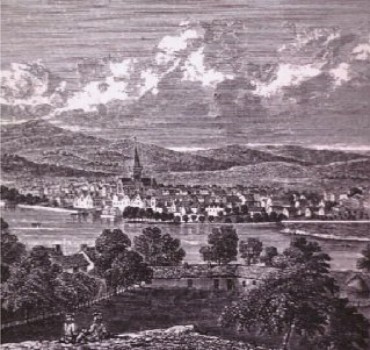
The image above is a drawing of Perth in 1697.
Perth is an ancient city situated on the Tay river in the heart of Scotland. Its name is probably derived from the Gaelic Bar-tatha meaning the height of Tay. Signs of habitation goes as far back as 80 AD when the Romans occupied a site north of the city. Perth owes its existence to its location at the first place on the Tay where it could be bridged; however its importance was established when the first king of a united Scotland was crowned in nearby Scone. Perth was considered the capital of Scotland until 1437 when King James I was murdered in the Dominican Monastery in the city and kings were crowned elsewhere from then on.
By the 1500s when our first Wychtouns appeared, Perth's population was about 6,000. Like all towns of that era, the plague struck repeatedly - first in 1512, again in 1585-87, in 1608 and again in 1645. Our first four generations lived through those times. After the last plague, it was time for humans to start killing each other again. A royalist sympathizer (Marquis of Montrose) captured Perth in 1644 only to have it retaken later. The English made a return visit in 1652 when Cromwell drove royalist sympathisers out of the lowlands and into the highlands. While Dundee was burnt and pillaged, Perth's capture was less draconian and it served as a garrison fortress for a period. The years up to the 1700s were not prosperous.
The 18th century did not start very well either. During the 1715 and 1745 rebellions, Perth was used as a Jacobite camp. This led to occupation by Hanoverian troops and Perth became a military city with Hessian troops kept in Perth to keep order in the area. Gradually, daily life became settled and Perth began to expand. Trade resumed and the port became prosperous, the leather trade continued to prosper, and a new linen industry grew up in Perth. This industry soon became the city's mainstay during the 19th century. Joining it were two associated industries - dyeing and bleaching. Whisky distilling had been part of Perth's economy for centuries but in the 1800s, it became a major industry. Other industries in the 1800s that had only a temporary period of prosperity include cotton fabric manufacturing, flax and yarn spinning, ship building, and printing.
With increased prosperity came city improvements, including a piped water supply, an infirmary, gas lights, a railway, and horse-drawn trams. In time, sanitary conditions also improved although a cholera epidemic in 1832/33 did kill 148 people. However, Perth's importance in Britain/Scotland's economy began to decline. During the 19th century, Perth's population doubled, however this was during a period when Britain's population quadrupled. In effect, Perth was growing relatively smaller and less important. By the turn of the century, even Perth's linen and dyeing industries had faltered and the downward trend accelerated.
Sources
Various web sites, including
A short history of Perth (http://www/localhistories.org/perth.html)
Gazetteer for Scotland (http://www.geo.ed.ac.uk/scotgaz/towns/townhistory155.html)
Further reading: Wighton Families in Perth